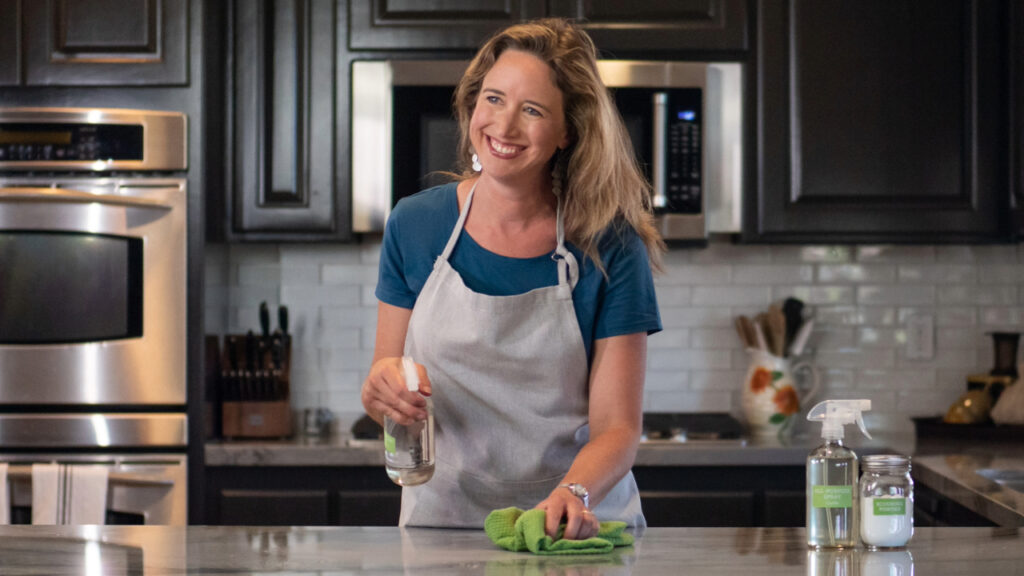
Here’s the TLDR* short-and-sweet of it: There are two Dr. Bronner’s products, the Castile Magic Soap and the Sal Suds Biodegradable Cleaner, that can replace most conventional housecleaning products. Add to these a few other everyday ingredients—white vinegar, baking soda, lemons—and you have a complete housecleaning arsenal.
*Too Long Didn’t Read.
Now for the long version…
Save space, money, and peace of mind
Save space
First, look at your cleaning cabinet/shelf/bucket or wherever you stash your cleaning products. Imagine what the space would look like with just these few items. (Here’s my own cleaning cabinet.)
Save money
Then I want you to pull up your receipt for buying these items. Add up what you’ve spent on your all-purpose spray, laundry detergent, dishwashing detergent, mopping solution, car washing solution, and toilet cleaner. One bottle of Dr. Bronner’s Castile Magic Soap or Sal Suds replaces all of these. And because they’re both concentrated and get diluted for each use, one bottle will do all of these tasks many, many times. (More on this cost breakdown in my article on the cost savings of green cleaning.)
Save peace of mind
On top of all this, there’s a very difficult metric to calculate: health. I can’t put a number on the hazard caused by filling the air of living spaces with problematic volatile organic compounds (VOCs), but the respiratory harm caused by bleach, ammonia, and other vaporous cleaners is well documented. (I’ve got more research to link here than I have words to link them to.) These fumes are unavoidable not only for the person cleaning but also for anyone in the space for hours afterward. Anyone with asthma, COPD, or other respiratory sensitivities should take special care to avoid these VOCs, but they’re not great for any of us.
So, if you’re interested in more space and more money and more peace of mind, this one’s for you.
Quick Links to Use This, Not That
- All-Surface Cleaning Spray
- Glass Cleaner
- Dishwashing by Hand
- Laundry Detergent
- Fabric Softener
- Mopping
- Oven Cleaner
- Scouring Powder
- Soft Scrub
- Toilet Cleaner
- Dusting Spray
- Air Freshener
- Carpet Cleaning Solution
- Carpet Freshener
But first, a note on fragrance
I could spend a lot of space discussing the problem of fragrances in housecleaning products. More and more, I see fragrance as the greatest problem of the products we use. This isn’t because it’s the worst ingredient you’ll find, but rather because it’s the most unavoidable. While ingesting or touching products happens occasionally, what happens constantly is breathing. As I mentioned above, anyone who cleans and anyone who enters the space that has been cleaned is going to breathe in the fragrances, and with their thousands of unknown ingredients protected as trade secrets, they harbor many undesireables such as formaldehyde, benzene, and phthalates.
While there’s a lot more to say on this, I want to get to the crux of my topic here—what to use instead. So allow me to say, in brief: the vast majority of fragrances in conventional products are not your friend.
All-Surface Cleaning Spray
Use This:
In a spray bottle combine:
- 1/4 c. (60 mL) Castile Magic Soap OR 1 Tbsp. (15 mL) Sal Suds
- 1 quart (1 L) of water
- Optional – 20 drops tea tree pure essential oil
Spray surfaces and wipe with a damp cloth. Use this on countertops, faucets and fixtures, sinks, showers and tubs, toilets, appliances, doorknobs and light switches, and just about anything else that can get wet and needs washing!
Not That & Why:
Skip the bleach and antibacterial sprays. And skip the variety. There is no need for a different cleaner for every type of surface when a mild simple soap or detergent will clean them all. Stone, wood, tile, stainless steel, acrylic.
It is especially important to consider the safety of ingredients in a spray cleaner because the act of spraying will propel these ingredients into the air where they easily are breathed into our bodies. Make sure your spray products don’t contain harmful VOCs.
Antibacterial ingredients are common in spray cleaners. These are both unnecessary and harmful. The CDC regards them as rarely needed in the home, and the WHO has identified the misuse and overuse of antimicrobials in the home as one of the primary causes of antibiotic resistance and the development of superbugs. Soap and detergent clean effectively by removing contaminants, not killing.
Lastly, many all-purpose sprays rely on quaternary ammonium compounds (quats), which release formaldehyde. Problematic as it is that formaldehyde is a known human carcinogen, the more immediately noticeable impact is that 1 in 12 people in the United States has a contact allergy to formaldehyde or with repeated exposure will develop one.
Glass Cleaner
Use This:
Combine in a spray bottle equal parts:
- Distilled white vinegar
- Water
Alternatives: If you particularly do not like the smell of vinegar, two other options are pure, fresh club soda, or scenting the vinegar by soaking citrus rinds or herbs in the vinegar for several days and then straining it out.
Not That & Why:
Skip the alluring blue liquids. Skip the ammonia. Conventional glass cleaners are not the most problematic of products, except ammonia which is quite problematic. However, they are unnecessary and often contain fragrances that I mention above and dyes. And they’re more expensive than vinegar and water. If your glass needs more of a wash, use the All-Purpose Spray.
Dishwashing by Hand
Use This:
Depending on how you like to wash dishes:
- In a sink full of water: Add 1-2 Tbsp. (15-30 mL) Castile Magic Soap OR ½–1 ½ tsp. (2.5 mL–7.5 mL) Sal Suds.
- For a single pot or large dish: Use a small squirt of Castile Magic Soap OR 1 drop of Sal Suds, adding more if needed.
- In a soap-dispensing dish brush: Use a 1:5 dilution with Castile Magic Soap OR 1:10 with Sal Suds.
- For large objects like cookie sheets or pastry mats: Spray with All-Purpose Spray (¼ c. Castile Magic Soap [60 mL] OR 1 Tbsp. [15 mL] Sal Suds in 1 qt. [1 L] water) and wipe with a wet cloth.
My personal method: I keep a squirt bottle beside my sink with ½ c. (120 mL) Sal Suds and 1 qt. (1 L) water and use a small squirt on a dishcloth or in a pot, and a larger squirt for a sinkful.
To avoid water spots in hard water conditions, dry dishes by hand.
Unfortunately, Dr. Bronner’s products are too bubbly to use in the dishwasher, so we don’t recommend it, but the Environmental Work Group’s Guide to Healthy Cleaning is a great place to look for low-tox products: https://bit.ly/EWGsCleanGuide
Not That & Why:
Skip the colored, highly scented, thick but not concentrated liquids. Conventional dishwashing detergents with their increased viscosity (thickness) are actually less concentrated than Dr. Bronner’s, so they require a lot more product per use, plus they can be more difficult to rinse so they take more water to remove the residues. There’s also the biodegradability concern downstream, and of course the fragrances.
Can I pause here to say I don’t understand the idea of fragrances sticking around on my dishes? I don’t want my water bottles or my coffee cups to taste like Spring Rain or Lemon Fresh (scents I just made up but I doubt would taste either like spring rain or lemons).
Additionally, ethoxylated surfactants such as Sodium Laureth Sulfate (SLES) are common in conventional detergents. The process by which they are made creates the contaminant byproduct 1,4-Dioxane, a suspected human carcinogen.
Laundry Detergent
Use This:
Machine Washing:
- 2–4 Tbsp. (30–60 mL) Castile Magic Soap OR 1–1 ½ Tbsp (15-22 mL) Sal Suds for HE washers. In hard water with the Castile Magic Soap, add ½ c. (120 mL) vinegar to the rinse cycle. Double these amounts for standard washers.
Optional booster for whitening/deodorizing grubby loads:
- ¼ c. (60 mL) baking soda added to HE wash cycle. (Use ½ c. [120 mL] in standard washers.)
To extend the life of your fabrics, you’ll want to use the least intensive washing method needed to get fabrics clean, so don’t reach for the booster unless the situation warrants it.
Handwashing:
- 1 capful Castile Magic Soap OR ½ capful Sal Suds to sink of cold water.
Stains:
- For broad stains like ring around the color, dilute Sal Suds 1:1 with water in a spray bottle.
- For acute stains: Wet fabric & apply full-strength Sal Suds or Castile Magic Soap directly to stain. Let sit 20 minutes before laundering.
- For stubborn stains: Wet fabric, sprinkle with baking soda or for the next level (after ensuring color fastness) with an oxygen bleach. Then spray with 1:1 dilution of Sal Suds. Let sit 20 minutes, then launder.
Not That & Why:
Skip the detergents with their quats, ethoxylated surfactants, unnecessary dyes, artificial scents, and added softeners. More than with any other household cleaner, the issue here is residues. Laundry detergents and fabric softeners are substances that we will come into full body contact with if there are residues. We will wear our clothes, dry ourselves with towels, and sleep on sheets. With this in mind, consider that conventional laundry products are designed to leave residues on fabrics in the form of fragrances and softeners. The fragrance in laundry detergents are some of the most powerful and enduring (not a good trait here) among household cleaners, designed to linger for weeks.
The problem isn’t just about breathing the fragrances, as if those aren’t problematic enough already. Research has shown that 1 in 10 people experience allergic contact dermatitis from physical contact with fragrance. This contact will happen with scented laundry products. Similarly, a common preservative in laundry detergents is methylisothiazolinone, which has high incidence of allergic contact dermatitis and sensitization.
Fabric Softener
Use This:
For softening & static reduction
- Use vinegar in place of liquid fabric softener or spray a clean washcloth lightly with vinegar and toss in dryer.
- Use 4-6 wool dryer balls for softening, static reduction, and reducing drying time.
- Air dry clothes to reduce static caused by friction of fabrics rubbing together.
- Do not over dry fabrics, as the friction between dry fabrics creates more static.
For de-wrinkling
- Remove clothes from dryer immediately at the end of the cycle and fold or hang.
- Wet your dryer balls or dampen a washcloth or hand towel and throw them in with the wrinkled clothes. Check after 20 minutes.
- Air dry clothes.
For scenting
- Use well-sealed herbal sachets in the dryer.
- Store clothes with herbal sachets or even unwrapped Dr. Bronner’s Bar Soap!
- Store clothes with a cotton pad sprinkled with a few drops of essential oil. Be sure the essential oil does not touch clothes to smudge them.
- Accustom yourself to less scent in your fabrics.
Not That & Why:
Skip all fabric softeners and dryer sheets. Fabric softeners are one of my primary villains. They are designed to leave residues on fabrics, which not only degrade fabrics, but get on us. See my discussion with laundry detergents about the impact of physical contact with fragrance. Further, fabric softeners often rely on non-biodegradable ingredients like dimethicone, siloxanes, and other silicone derivatives. Dryer sheets, which are pieces of polyester coated with fabric softeners, produce non-biodegradable waste and carry the same problems as liquid fabric softeners.
Mopping
Use This:
Depending on how you like to clean floors:
- With a bucket: In a 1-gallon (4 L) bucket of water, add either 2 ½ Tbsp. (37.5 mL) Pure-Castile Magic Soap OR 1 tsp. (5 mL) Sal Suds.
- With a squirt bottle: (For smaller areas) Add either 3 drops of Sal Suds OR 2 tsp. (10 mL) Castile Magic Soap to a quart or liter bottle filled with water. This dilution works in a spray mop, too.
Use the above on wood, marble, tile, ceramic, laminate, and vinyl. There’s no need to rinse at these dilutions. With any floor type, avoid puddling and standing water.
Not That & Why:
Skip the mopping solutions with their dyes, fragrances, and unconcentrated formulas. Conventional mopping solutions often require much more product per use, are prone to leaving residues, and emit fragrances. Because they leave residues, they cause buildup on floors that dull the finish over time.
Oven Cleaner
Use This:
A few great techniques:
- Lemons: Fill a 4-qt. pot with quartered lemons and 1 cup (240 mL) water. If you don’t have lemons, use a 1:1 vinegar/water solution. Cover the pot and heat the contents on the stove. Simmer, covered, for 15 minutes or so until the lemons are soft. Keep the lid on. Transfer the pot to the oven, remove the lid, and immediately shut the oven door. Leave it closed for at least an hour. Then open the oven and immediately wipe off the loosened crud.
- Baking soda paste: If time is on your side, make a paste of baking soda and water and spread it on the crud. Let it sit overnight, and then scrape off the paste with a plastic scraper.
- Heat: The self-cleaning feature on some ovens uses heat over 600+F (315+C) to burn everything off. There are a few downsides, though, in that this does emit fumes, so open windows, turn on vents, and consider leaving the space. It also uses a lot of energy.
Not That & Why:
Skip the aerosol and gel oven cleaners with sodium or potassium hydroxide and butoxydiglycol, which are even more toxic when airborne via aerosols. It is telling that there isn’t a single oven cleaner that the Environmental Working Group rates above a D. Conventional oven cleaners have exchanged safety for convenience. They promise quick results and a crud-free oven, but they do this with super caustic ingredients (sodium and potassium hydroxide have a pH of 14—the most extreme the scale measures) that wear down surfaces over time, and if any get on your skin, or far worse ingested, the damage can be dire and irreversible. Read the hazard warnings for what I’m talking about.
Scouring Powder
Use This:
- Baking soda.
Keep baking soda in a shaker jar (an old spice jar is great) and sprinkle it on any surface in need of scouring: kitchen sinks, bathtubs, even grimy glass. Scrub with a microfiber cloth or brush, and rinse well. If you want a little more to do, you can use a fork to mix in a few drops of your favorite essential oils.
Not That & Why:
Save your money and skip the scouring powders with strong acids and large granules. While conventional scouring powders certainly cost more than baking soda (buy it by the big bag or box), they also contain ingredients that are unnecessarily complicated and can etch surfaces.
Soft Scrub
Use This:
This is one of my favorite GIY concoctions, inspired by Karen Logan’s book Clean House, Clean Planet:
- 1 c. (240 mL) Castile Magic Soap OR ¼ c. (60 mL) Sal Suds
- 3⅓ c. (800 mL) baking soda
- 1 c. (240 mL) water
- ¼ c. (60 mL) white vinegar
In a big bowl, combine the baking soda with the Castile Magic Soap OR the Sal Suds. Mix it with a fork until well blended and no lumps remain. Add in the water and mix thoroughly again. Add the vinegar and keep stirring until no lumps remain. If needed, add additional water until mixture is a pourable consistency. Pour the solution into an empty quart bottle, using a funnel.
To use this, squirt it over the surface and wipe with a damp microfiber cloth. Rinse with a wet cloth.
Not That & Why:
Skip the soft scrubs containing bleach, sodium hydroxide, and ethoxylated compounds. In soft scrub you’ll find many of the aforementioned problems, including formaldehyde releasers like quarternium compounds, ethoxylated surfactants, and VOC emitting antibacterials and fragrance. All of this at a higher cost that simple baking soda.
Toilet Cleaner
Use This:
I’ve got three options for you here. I switch between all of these depending on what’s handy, what’s needed, and my mood:
- Method 1: All-Purpose Spray: Using the All-Purpose Spray listed above, spray the bowl thoroughly and brush with a toilet brush.
- Method 2: Full strength Castile Magic Soap or Sal Suds: Squirt a very small amount of the undiluted Magic Soap or an even smaller amount of the Sal Suds directly on to the toilet bowl brush. Brush the bowl thoroughly.
Boost for Methods 1 or 2: For extra scrubbing, sprinkle baking soda onto your toilet brush before scrubbing.
- Method 3: Using the GIY Soft Scrub above, squirt the foam around the bowl and under the rim. Brush well.
Not That & Why:
Skip the toilet bowl cleaners with bleach, hydrochloric acid, sodium hydroxide, or hydantoin antimicrobials. Toilet bowl cleaner is one of the harshest of household cleaners. It’s meant to cling to surfaces, even under water. It’s meant to eat through various biological or mineral coatings. It takes durable and intense ingredients to do this. One “Oops” from me, or a kid or a dog getting somewhere they’re not supposed to, which happens, and I’d have a real problem.
Septic systems, which I have, rely on helpful bacteria and enzymes to work. Killing them all with bleach or other antimicrobials kills the working of the system. While the impact is more invisible with a municipal sewer system, at least invisible to us when we flush the toilets, the impacts to the downstream aquatic environment is significant.
Dusting Spray
Use This:
- A microfiber cloth dampened with water.
Not That & Why:
Skip all dusting sprays and wipes. Both are unnecessary and problem-causing. They do not enable your dusting cloth to pick up more dust. They do not prevent future dust from landing on surfaces. All they do is waste your money and take your cabinet space, and when sprays are used, emit various VOCs and propellants into the air. The wipes generate non-biodegradable trash. They often leave a residue on surfaces to which more dust can cling.
Air Freshener
Use This:
While I’ll give you a recipe in a moment, more important to air freshening are a few activities:
- Find and eliminate the source of any odors: Vacuum carpets and upholstery thoroughly. Dust regularly. Take out trash & recycling, clean litter boxes, freshen garbage disposals by grinding lemon slices.
- Open windows regularly. This is the best way to flush out your air. If opening windows is not possible, use an air purifier with a filter having a MERV rating of 13 or higher.
- Change filters on HVAC systems, vacuums, and purifiers.
- Turn on the stove vent when cooking.
- Stop using products that emit VOCs and other hazards into the air.
Ok, now that all those steps are taken, I’ll give you some recipes:
Air freshening spray:
Fill an empty Dr. Bronner’s Hand Sanitizer (or similar) bottle, or other fine-misting spray bottle with
- One part vodka or other clear, non-scented alcohol
- One part water
- 10 drops of your favorite essential oils (add more to reach desired scent)
Mist lightly in rooms or cars.
Simmering potpourri:
Combine in a small saucepan or small 1 qt. (1.5 L) slow cooker your favorite blend of the following:
- Whole spices such as cinnamon stick, cloves, nutmeg, star anise, allspice.
- Fruit such as apple slices, orange slices, lemon slices, cranberries.
- Herbs and botanicals such as juniper berries, lemongrass, sage, rosemary, ginger.
Cover aromatics with water and simmer over low heat. Add water as needed to keep potpourri simmering.
Not That & Why:
Skip artificially scented air freshening sprays, plug ins, and candles. Conventional air fresheners are concentrated forms of the problematic fragrances I’ve already discussed, causing headaches, respiratory issues, and more. They may cover unpleasant odors, but they do not solve them. The smell of clean should be the smell of nothing at all.
Carpet Cleaning Solution
Use This:
For spot treatment make this “Lite” version of the All-Purpose Spray (or use the All-Purpose spray lightly):
- ½ Tbsp. (7.5 mL) Sal Suds OR 2 Tbsp. (30 mL) Castile Magic Soap
- 1 quart (1 L) of water
Spray on spots and work into carpet. Use a wet clean cloth to remove stain and rinse. Use “Lite” solution as a pre-treatment ahead of a full cleaning.
For full carpet cleaning with a machine:
- 1 drop of Sal Suds OR ½ Tbsp. (7.5 mL) Magic Soap in water for the cleaning.
- Optional for deodorizing: 1 cup of white distilled vinegar in water for the rinsing.
To clean the carpet, fill the cleaning solution compartment with water and add the Sal Suds or Castile Magic Soap. Run machine as directed, being careful not to overspray the carpet. If the carpet needs further deodorizing, fill the main water compartment with water and add 1 cup of vinegar. Run machine over carpets again.
Not That & Why:
Skip the carpet cleaning solutions containing ethoxylated (“-eth”) ingredients and “fragrance.” In carpet cleaning solutions you again will find quats and ethoxylated surfactants with their carcinogenic stowaways, plus the fragrances used to cover odors instead of effective cleaners used to remove the cause of odors.
Carpet Freshener
Use This:
For light deodorizing in the interim between full carpet cleanings use:
- Baking soda
Fill a shaker jar with baking soda. Sprinkle the carpet liberally and brush it in with a broom. Let it sit for 10 minutes. Vacuum it out with a vacuum with a HEPA filter. If you’d like a light scent, mix in ten or so drops of essential oil into the baking soda beforehand. Essential oils are not recommended around cats or other sensitive pets.
Not That & Why:
Spray carpet fresheners cover odors but do not absorb them like baking soda can. Plus, they rely on fragrances that fill the air with all the problematic compounds previously mentioned.
Wrapping it up
My friends, the beauty of a blog is that I can add to it. This means if you have a housecleaning product you’d like me to suggest an alternate for, let me know in the comments and I’ll add it in!
Further reading
- My Cleaning Cabinet
- The Low Cost of Green Cleaning
- How to Wash Dishes with Dr. Bronner’s
- Green Cleaning and Household Harmony
Sal Suds cleaner shows >60% biodegradation after 28 days per ISO 14593.
This use and many more are in my book, Soap & Soul: A Practical Guide to Minding Your Home, Your Body, and Your Spirit with Dr. Bronner’s Magic Soaps, available now in hardback on DrBronner.com or at your favorite bookseller, and as an eBook and audiobook (read by me!) from wherever you download or listen.

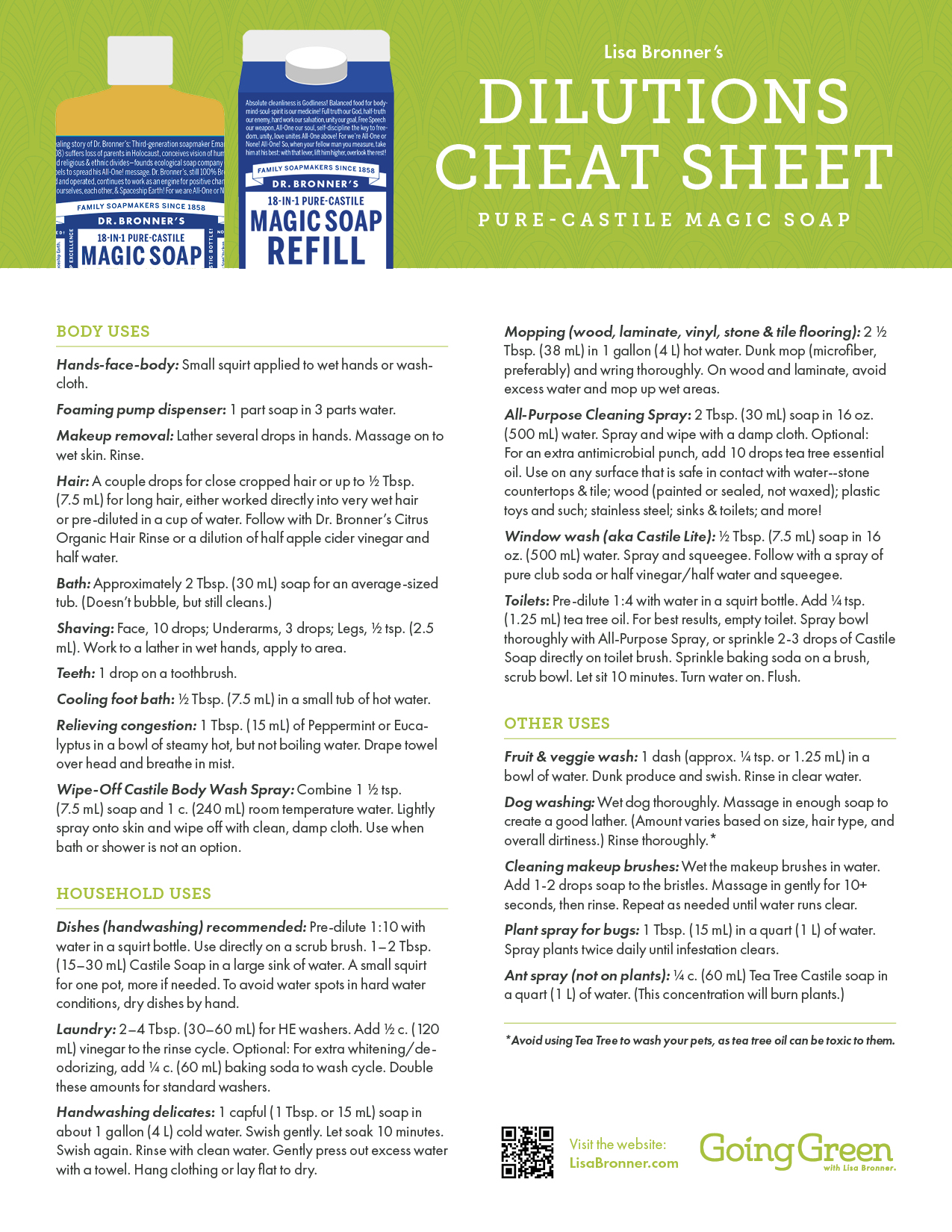
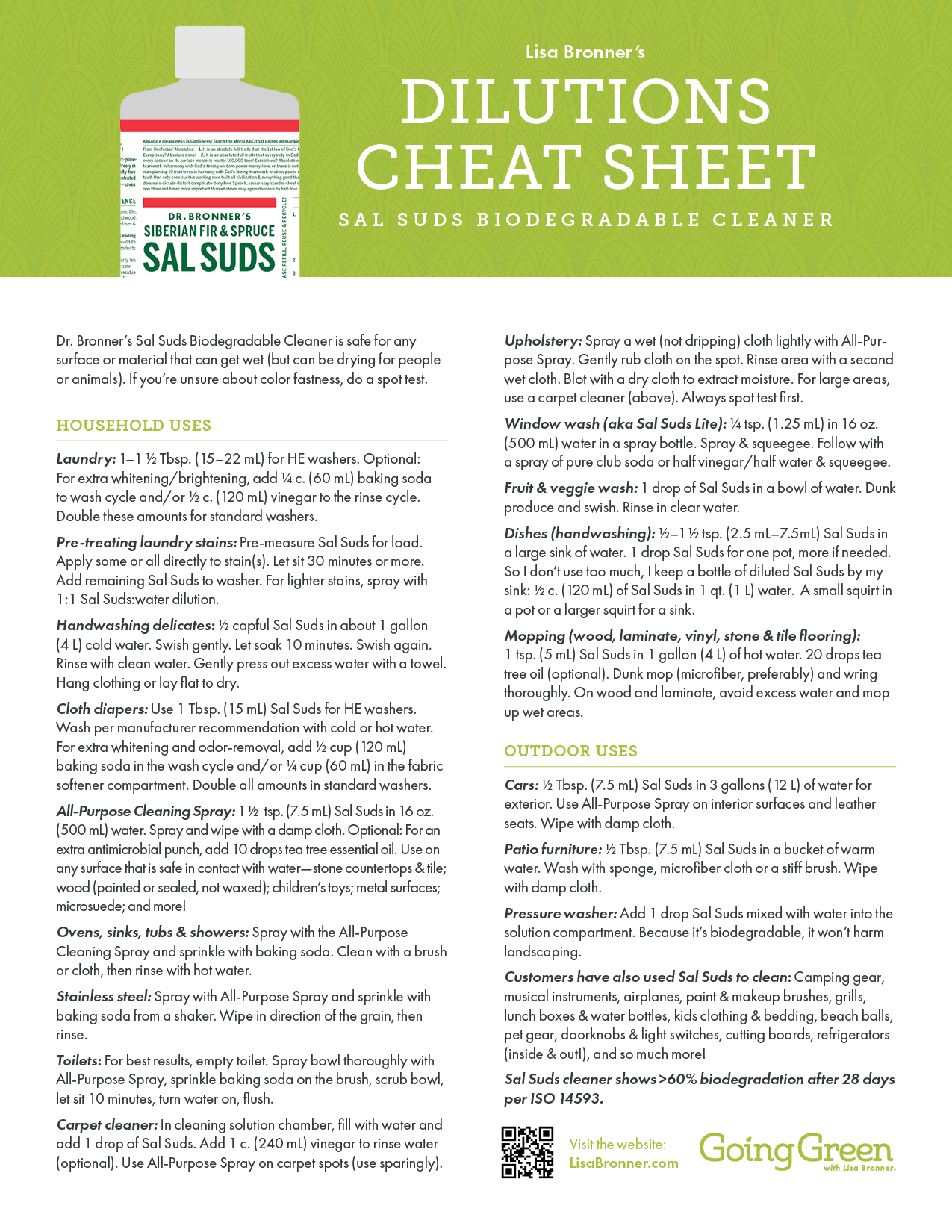
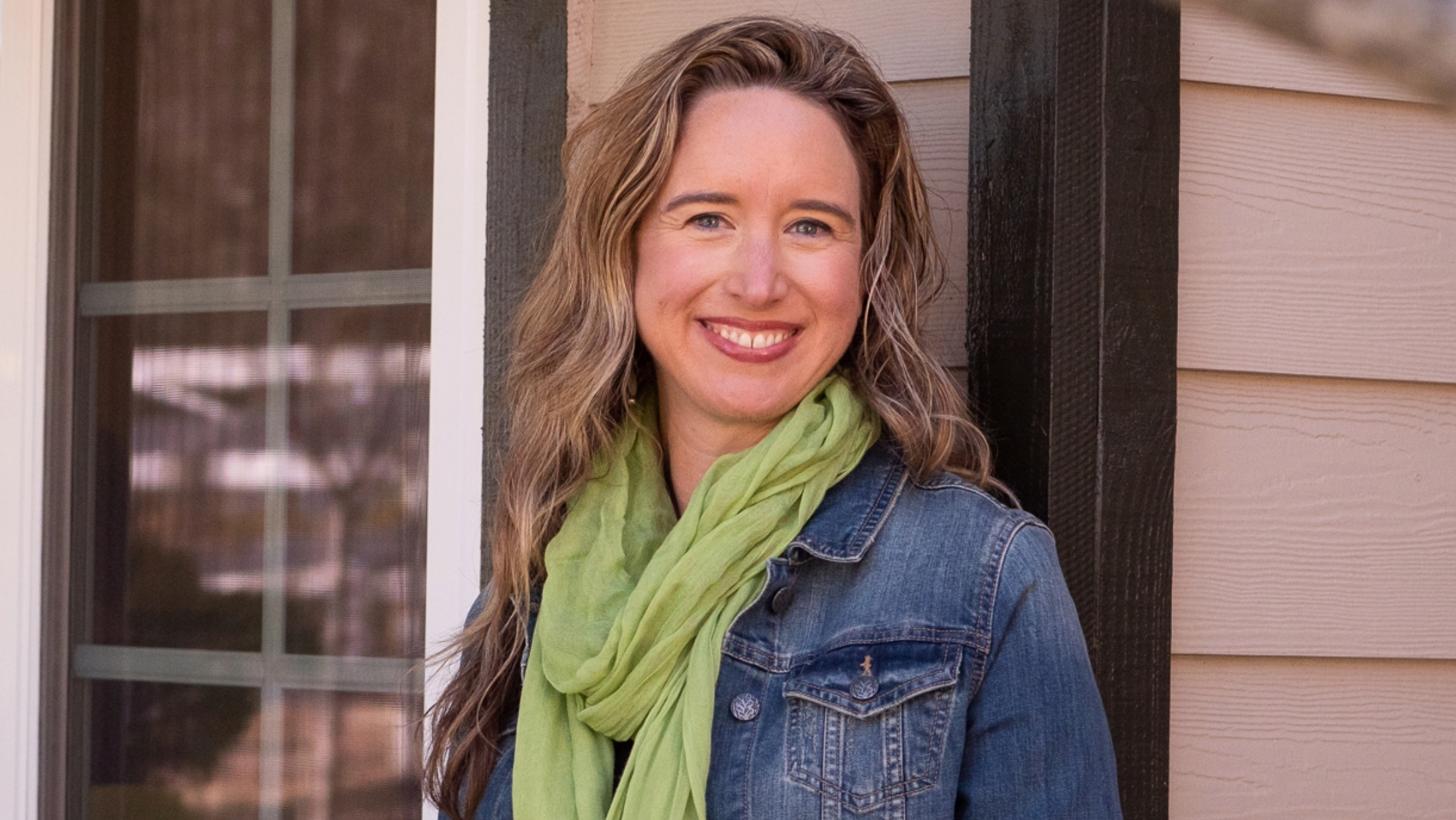
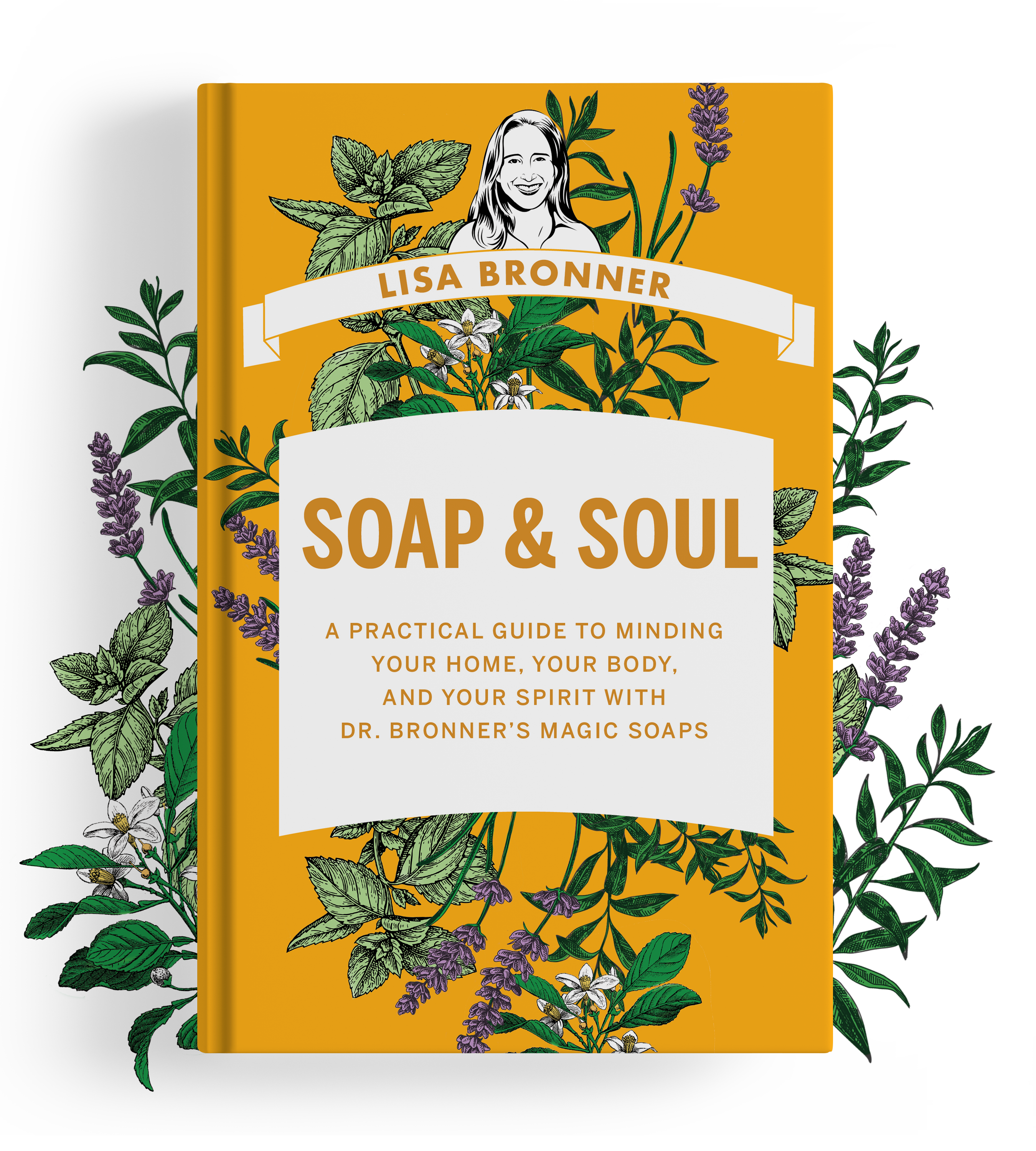
Thanks for all the great DB products. I started my GIY journey when our first daughter was born about 6 years ago. I’ve been using a combination of DB and another brand I’ll call BB. Have you considered selling pre-marked spray bottles or foaming soap pumps to offer as GIY kits?
Hi James- I’m glad our family’s products have been a help to you! We do toss the idea of one or both of these around from time-to-time. If we do venture into packaging, you can be sure I’ll be posting about it!
Thank you for this. I wanted to ask if it’s okay to always just use the All Purpose spray (made with sal suds) for glass windows and mirrors, instead of vinegar/water spray.
BTW, I love your book Soap and Soul! It is very well-written and informative!
Hi J.- Thanks for your kind words about my book! There’s no concern using Sal Suds and water exclusively for glass, but I recommend a slightly different dilution than the All-Purpose Spray. I call it Sal Suds Lite: Add ½ tsp. (2.5 mL) in a quart (1 L) of water. Spray and squeegee. If it’s helpful, here’s a link to my article on cleaning glass and screens, https://www.lisabronner.com/green-cleaning-mirrors-windows-screens/
I have found that a 3% Hydrogen peroxide is a great stain remover for organic stains. It will take several treatments to remove the stain. But it has worked for me on hot chocolate on beige carpet, red wine stains, and tomato sauce. I also use it to remove stains from my vintage table cloths and linen. Oh and Dr Bonner’s has been my go to soap for years.
That’s great, Carol! Thanks for sharing!
When I dilute Sals Suds with water to make a solution for the in sink’s liquid soap dispenser, the mixture is somewhat thin and sprays a little uncontrollably. Is there an easy safe way to thicken the solution so it comes out off the dispenser more controlled?
Hi Mark – Your best bet is to use a foaming dispenser. There isn’t a good way to thicken a Sal Suds/water solution without diminishing its cleaning ability. Try a dilution of 1:8 and see how you like it. Your question has made me curious because I haven’t actually used the Sal Suds in a foamer, but I’ll give it a try, too. Let me know what you think.
I love your products and all your tips for using them.
I’m going to be using them for everything with your instructions.
The money saving is terrific!
I’ll be buying your book. Soap & Soul”
Thanks, Lisa!
Kathy
Hi Kathy- I’m so glad my tips are helpful for you!
Thank you for the handy list of easy recipes for cleaning around the house. I love Sal Suds and the Dr. Bronner liquid soap which I use to make foaming hand soap using a glass refillable dispenser.
I would purchase glass refillable dispensers with my soap if you had them available.
Hi Tony- We don’t currently have plans for a glass dispenser, but I’ll share your suggestion with our team!
Just wondered about a film left by the Castile soap. I use your soap diluted as a hand soap and noticed my white sink looses it shine, also had that happen with my tile floor. Any solutions?
Hi Diana- What you’re noticing is soap scum. This happens in hard water situations where the minerals in hard water react with a true soap such as Castile Soap and leave behind a white precipice or film. To prevent this build up, wipe the sink periodically with an absorbent cloth so there are no dissolved salts sitting on the surface when the water evaporates. An occasional spritz with a 50-50 dilution of water and vinegar (which is also my glass cleaner) will dissolve the salts. However, do not use vinegar on a soft stones, such as marble or travertine, as it can etch the surface. Another option to remove is a sprinkle of baking soda. Scour and rinse. For floors, give Sal Suds, our biodegradable cleaner a try as it doesn’t react with hard water in the same way. If you’re interested in reading more about soap scum, see my blog post about it. https://www.lisabronner.com/scum-scum-go-away/